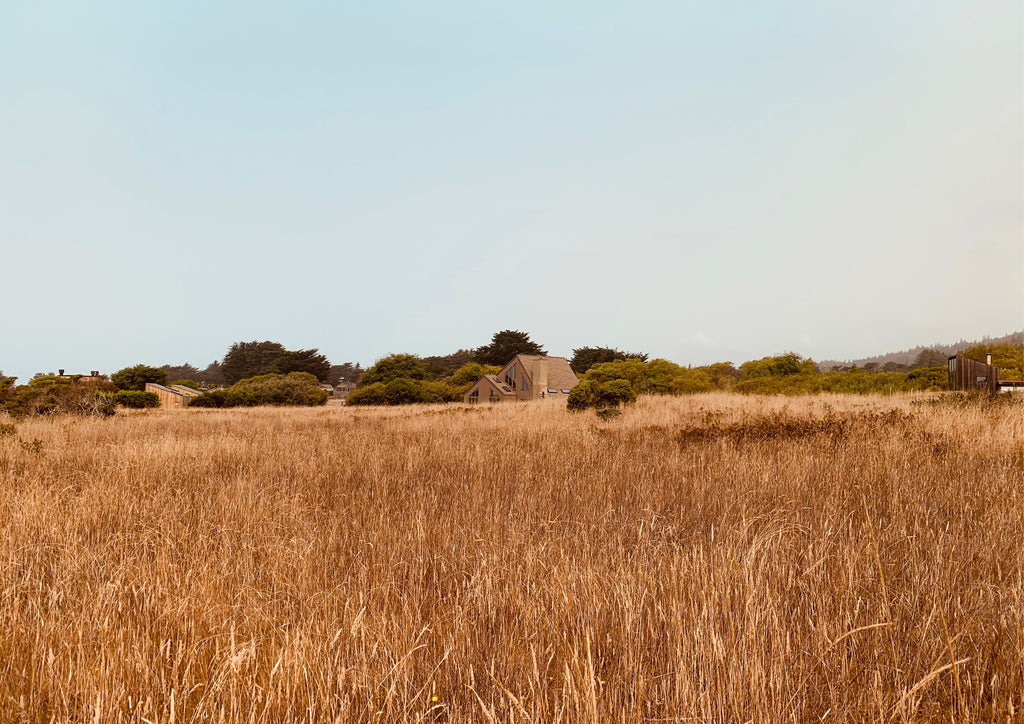
On my way to visit Sea Ranch for the first time last summer, that oft-referenced line about the journey being more important than the destination kept coming to mind. Because, getting to Sea Ranch, the idyllic residential development hugging the northern Californian coast between Bodega Bay and Mendocino, does feel like more of a pilgrimage than a trip. The route that takes you there is circuitous, often eerily quiet (particularly for city folks like myself accustomed to a near constant din), snaking past clusters of redwoods and cypress trees, limestone cliffs, the Pacific Ocean a constant presence, anticipation building with every bend of the road. Is this trek somehow more important than the destination itself, no, but in the case of Sea Ranch the land that comprises and surrounds it is a vital part of the development’s origin story.


“It was like finding paradise at the end of the world,” Sea Ranch’s graphic designer Barbara Stauffacher Solomon has said of the bucolic ten-mile coastal stretch. A former sheep ranch, the 5,200 acres were purchased in 1963 by Oceanic Properties, and its development in the years that followed was helmed by architect Al Boeke. He would assemble a dream team of creative minds – Solomon (the brains behind Sea Ranch’s now iconic supergraphics), plus landscape architect Lawrence Halprin, and architects Charles Moore, Richard Whitaker, Donlyn Lyndon, William Turnbull, and Joseph Esherick – to collaborate on what would come to be regarded as a visionary residential development. That’s because it was a departure, in both style and substance, to its suburban counterparts at the time. The vision was never to create a Pleasantville with ocean views, but to conceive of a community that would exist completely in accord with nature.
To wit, before building commenced Halprin was tasked with studying the local ecosystem, measuring wind patterns and cataloguing plants, so their impact on the environment would be as inconspicuous as possible. “The richly varied surfaces, edges, and patterns of natural growth were interwoven with the bold, linear geometries of human intervention, already expressed here in hedgerows, fences and roads,” Lyndon once said. “Halprin’s plan set out to take advantage of both of these characteristics, using arrangements that matched the ecology and the scope and the scale of the landscape better than the conventional patterns of incremental, parcelized development would.”


That meant that any building itself would be severely limited. Fifty per cent of the land would be left untouched, and the structures that were built would be reflective of the landscape (unfinished redwood was one exterior material and all houses are unpainted) and camouflaged amidst it. To that end, tens of thousands of pines were planted and houses were ensconced amidst hedgerows with New Monterey cypress trees, protecting them from the wind while also offering ocean views. The Sea Ranch manual further underscores their defining principles and guidelines that owners, present-day ones included, are expected to abide by before doing any of their own gardening or renovation. Buildings, it reads, should not call attention to themselves. Property boundaries should not be emphasised. The spaces adjacent to the buildings should flow from the site to the Commons, minimising the sense of separation. Plant materials must be selected from the approved plant list and should not materially change the character of the existing setting. The goal of The Sea Ranch planning is to maintain, restore and reinforce the native landscape it reads. The rules, while exhaustive, are integral for abiding by its original purpose.
“I became convinced that Sea Ranch could become a place where wild nature and human habitation could interact in the kind of intense symbiosis where ecology could allow people to become part of the ecosystem,” Halprin said. The buildings manifest a sense of being one with nature – an “integrated whole” as the manual lists – and when you’re there you are too. I certainly felt it. There was a sense of being completely off the grid, but not alone. A sense of collective reverence for the landscape. And, most blissful for me after many months of pandemic sheltering in New York City, a real palpable sense of peace. We walked the windswept beaches often spotting only one or two other people, collecting faded driftwood and tangled seaweed ribbons to erect miniature forts in the sand; meandered through narrow trails carved between the tall sea grass plucking wildflowers along the way to tie into haphazard bouquets; spent quiet mornings peering out at the cypress for the families of deer that frequently gathered; watched seals bask on the sand in the midday sun. It was, as Solomon first said, like finding paradise.


A lot has changed since Sea Ranch was first constructed. The utopia where one could once live in commune with nature, subject to skyrocketing housing prices and combined with the urgency of the climate crisis, makes Sea Ranch now seem like a time capsule of sorts. It’s a reminder of how things were, but perhaps, if we’re really lucky, it could also serve as a reminder of how they could be again. That kindred connection to the land on which it’s built is something that Sea Ranch embodies right down to its name. When the creatives behind its conception were brainstorming what their development should be called it was Solomon who landed on Sea Ranch, saying: “The name should be simple—it should belong naturally to the place.”
Words by Fiorella Valdesolo.
Photographs by Michele Outland.
Add a comment
5 comments